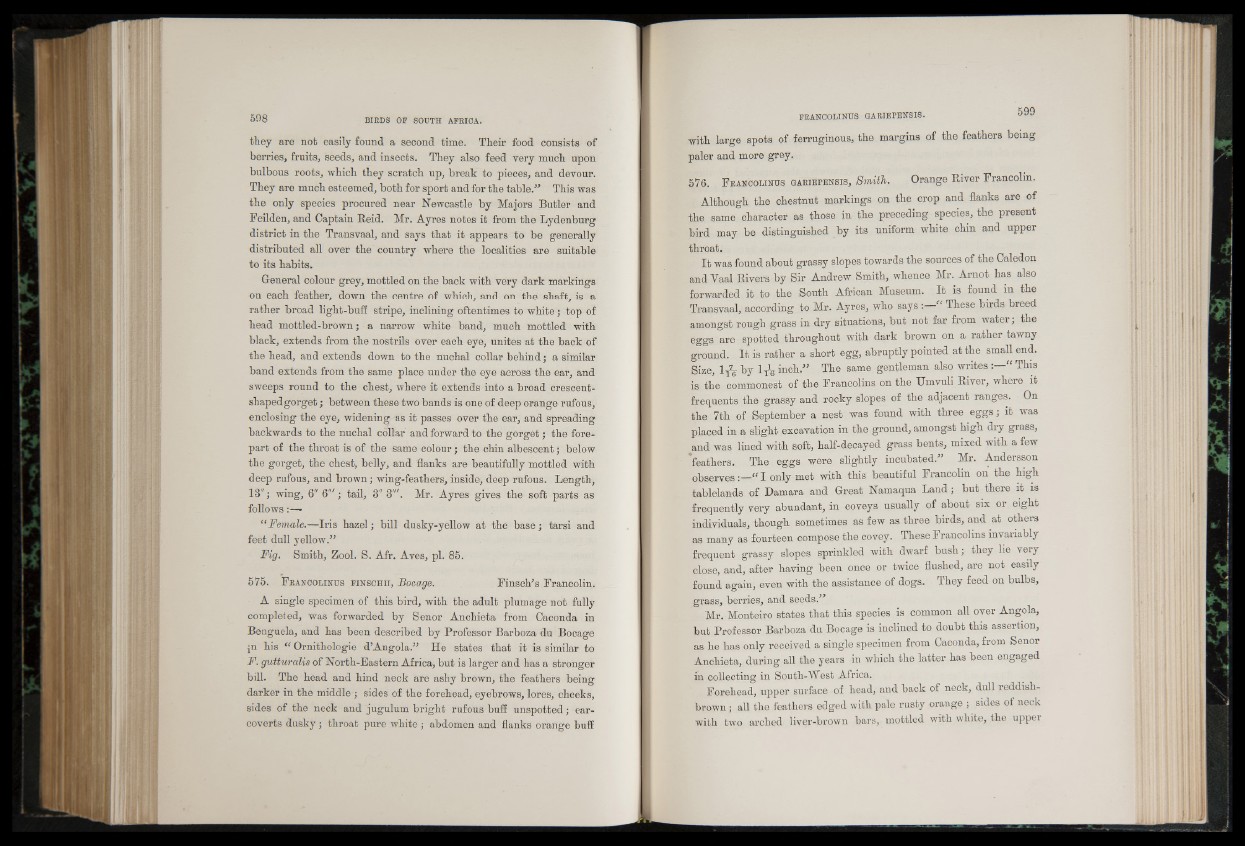
they are not easily found a second time. Their food consists of
berries, fruits, seeds, and insects. They also feed very much upon
bulbous roots, which they scratch up, break to pieces, and devour.
They are much esteemed, both for sport and for the table.” This was
the only species procured near Newcastle by Majors Butler and
Feilden, and Captain Reid. Mr. Ayres notes it from the Lydenburg
district in the Transvaal, and says that it appears to be generally
distributed all over the country where the localities are suitable
to its habits.
General colour grey, mottled on the back with very dark markings
on each feather, down the centre of which, and on the shaft, is a
rather broad light-buff stripe, inclining oftentimes to white; top of
head mottled-brown; a narrow white band, much mottled with
black, extends from the nostrils over each eye, unites at the back of
the head, and extends down to the nuchal collar behind; a similar
band extends from the same place under the eye across the ear, and
sweeps round to the chest, where it extends into a broad crescentshaped
gorget ; between these two bands is one of deep orange rufous,
enclosing the eye, widening as it passes over the ear, and spreading
backwards to the nuchal collar and forward to the gorget; the forepart
of the throat is of the same colour ; the chin albescent; below
the gorget, the chest, belly, and flanks are beautifully mottled with
deep rufous, and brown; wing-feathers, inside, deep rufous. Length,
13"; wing, 6" 6'"; tail, 3" 3'". Mr. Ayres gives the soft parts as
follows:—
“Female.—Iris hazel; bill dusky-yellow at the base; tarsi and
feet dull yellow/’
Fig. Smith, Zool. S. Afr. Aves, pi. 85.
575. F r a n c o l i n u s p i n s c h i t , Eocage. Finsch’s Francolin.
A single specimen of this bird, with the adult plumage not fully
completed, was forwarded by Senor Anchieta from Oaconda in
Benguela, and has been described by Professor Barboza du Bocage
jn his “ Ornithologie d’Angola.” He states that it is similar to
F. guttwraUsoi North-Eastern Africa, but is larger and has a stronger
bill. The head and hind neck are ashy brown, the feathers being
darker in the middle ; sides of the forehead, eyebrows, lores, cheeks,
sides of the neck and jugulum bright rufous buff unspotted; ear-
coverts dusky ; throat pure white ; abdomen and flanks orange buff
with large spots of ferruginous, the margins of the feathers being
paler and more grey.
576. F rancolinus g a r ie p e n s is , Smith. Orange River Francolín.
Although the chestnut markings on the crop and flanks are of
the same character as those in the preceding species, the present
bird may be distinguished by its uniform white chin and upper
throat.
I t was found about grassy slopes towards the sources of the Caledon
and Vaal Rivers by Sir Andrew Smith, whence Mr. Amot has also
forwarded it to the South African Museum. It is found m the
Transvaal, according to Mr. Ayres, who says : “ These birds breed
amongst rough grass in dry situations, but not far from water; the
eggs are spotted throughout with dark brown on a rather tawny
ground. It is rather a short egg, abruptly pointed at the small end.
Size, l T7g by lyg inch.” The same gentleman also w r i t e s “ This
is the commonest of the Francolins on the Umvuli River, where it
frequents the grassy and rocky slopes of the adjacent ranges. On
the 7th of September a nest was found with three eggs; it was
placed in a slight excavation in the ground, amongst high dry grass,
and was lined with soft, half-decayed grass bents, mixed with a few
feathers. The eggs were slightly incubated.” Mr. Andersson
observes:—“ I only met with this beautiful Francolin on the high
tablelands of Damara and Great Namaqua Land; but there it is
frequently very abundant, in coveys usually of about six or eight
individuals, though sometimes as few as three birds, and at others
as many as fourteen compose the covey. These Francolins invariably
frequent grassy slopes sprinkled with dwarf bush; they lie very
close, and, after having been once or twice flushed, are not easily
found again, even with the assistance of dogs. They feed on bulbs,
grass, berries, and seeds.”
Mr. Monteiro states that this species is common all over Angola,
but Professor Barboza du Bocage is inclined to doubt this assertion,
as he has only received a single specimen from Caconda, from Senor
Anchieta, during all the years in which the latter has been engaged
in collecting in South-West Africa.
Forehead, upper surface of head, and back of neck, dull reddish-
brown ; all the feathers edged with pale rusty orange ; sides of neck
with two arched liver-brown bars, mottled with white, the upper